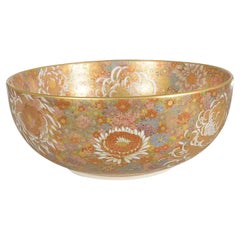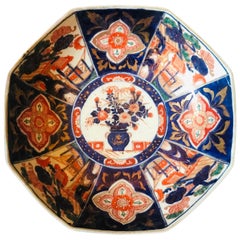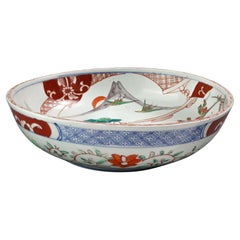Satsuma Decorative Baskets
to
1
1
1
1
1
1
1
1
Height
to
1
1
1
18
43
27
20
17
Creator: Satsuma
Japanese Satsuma Millefleur bowl, Meiji period. 30cm diameter.
By Satsuma
Located in Brighton, Sussex
A fine quality Japanese (Meiji period 1868-1912) Satsuma Millefleur bowl, painted with 'A thousand flowers' pattern & gilt decoration.
Signed to the base.
Batch 83 62047 DUAZN
Category
Late 19th Century Japanese Antique Satsuma Decorative Baskets
Materials
Porcelain
Related Items
Meiji Period Large Japanese Imari Bowl Centerpiece
By Imari Porcelain
Located in Vero Beach, FL
Meiji period large Japanese Imari bowl centerpiece
This large, distinctive, octagonal porcelain Imari bowl is painted in rich, inky blue, co...
Category
19th Century Japanese Meiji Antique Satsuma Decorative Baskets
Materials
Porcelain
Meiji period Japanese Arita bowl, c. 1850-1900
Located in Kenilworth, IL
Imari palette shallow bowl decorated in Imari colors simulating the Chinese famille verte palette (green with accents of aubergine, oxide red and underglaze blue). The interior of th...
Category
Mid-19th Century Japanese Meiji Antique Satsuma Decorative Baskets
Materials
Porcelain
Meiji Period Japanese Imari Bowl Attributed to Fukagawa, Circa 1880
By Fukagawa
Located in West Palm Beach, FL
Meiji Period Japanese Imari Bowl Attributed to Fukagawa, Circa 1880
Japan, 6.5" H x 12" Diameter
An exceptional Meiji-period Imari porcelain bowl attributed to the esteemed Fukagawa...
Category
Late 19th Century Japanese Meiji Antique Satsuma Decorative Baskets
Materials
Porcelain
Pair Of Satsuma Earthenware Vases "zenkozan" Japan, Meiji Period
By Satsuma
Located in Bilzen, BE
Pair of Earthenware vases from Satsuma Japan
Each side with different decoration
Signature under the base "Zenkozan" end of the Meiji period
Height 22 cm
Perfect condition
Category
Early 20th Century Japanese Meiji Satsuma Decorative Baskets
Materials
Earthenware
$1,184 / set
H 8.67 in W 3.94 in D 3.94 in
Large Antique Japanese Arita Imari Bowl Edo Meiji Period, 19th Century
Located in Amsterdam, Noord Holland
Large Antique 19th Japanese Arita Imari Bowl Edo Meiji Period Birds Flowers.
A very nice bowl.
Additional information:
Material: Porcelain & Pottery
Region of Origin: Japan
Period:...
Category
19th Century Japanese Edo Antique Satsuma Decorative Baskets
Materials
Porcelain
$721 Sale Price
24% Off
H 3.35 in Dm 7.29 in
Antique Meiji Period Japanese Satsuma Plate Figures with Mark Japan 19th Century
Located in Amsterdam, Noord Holland
Fabulous Japanese earthenware Satsuma dish depicting Figures. Satsuma Ceramic with mark. Japan – Meiji period (1868-1912)
Mark at the base: Made by Hotoda
Additional information:
M...
Category
19th Century Japanese Meiji Antique Satsuma Decorative Baskets
Materials
Porcelain
$950 Sale Price
20% Off
H 1.26 in Dm 6.15 in
Large Antique Meiji Period Japanese Cloisonne Bowl with Blue Dragon
Located in Long Island City, NY
A highly decorative antique Japanese Meiji period bowl decorated with cloisonne enamel patterns. The interior of the bowl is adorned with several panels with traditional benevolent s...
Category
Late 19th Century Japanese Meiji Antique Satsuma Decorative Baskets
Materials
Enamel
Japanese Meiji Period Cloisonne Bowl
Located in Hamilton, Ontario
Japanese Meiji period cloisonne bowl.
Category
19th Century Japanese Meiji Antique Satsuma Decorative Baskets
Large Antique Meiji period Japanese Satsuma Plate After a Figural Scene
Located in Amsterdam, Noord Holland
Fabulous Japanese earthenware Satsuma dish depicting different figural scenes.
Marked at the base.
Japan – Meiji period (1868-1912)
Condition
Perfect condition. Size: 32.5x5.7CM D...
Category
20th Century Japanese Satsuma Decorative Baskets
Materials
Porcelain
Antique Japanese Porcelain Meiji Period Arita Polychrome Bowl Dish 19th Century
Located in Amsterdam, Noord Holland
Sharing with you this unusual and magnificent bowl from the Meiji period (19th century). It has a very interesting and lovely blue and gold scene
Unmarked at the base.
Additional in...
Category
19th Century Japanese Meiji Antique Satsuma Decorative Baskets
Materials
Porcelain
$269 Sale Price
20% Off
H 2.37 in Dm 6.5 in
Antique Japanese Seto Satsuma Charger Japan Figure Relief Edo or Meiji
Located in Amsterdam, Noord Holland
This Fabulous Japanese Satsuma Style Earthenware Charger. With a central scene of what we think is an Arhat. He is carrying a fan in his hand and behin his head a halo is visible. Check the facial expression on the mans face Large part of the piece is in relief.
It is a Seto plate...
Category
19th Century Japanese Antique Satsuma Decorative Baskets
Materials
Porcelain
$1,118 Sale Price
20% Off
H 13.86 in Dm 2.49 in
Antique Meiji Japanese Satsuma Plate Japan Flowers Marked, 19th Century
Located in Amsterdam, Noord Holland
Lovely and small Satsuma dish.
Additional information:
Material: Porcelain & Pottery
Type: Vase
Japanese Style: Kutani
Region of Origin: Japan
Period: 19th century Meiji Periode (18...
Category
19th Century Japanese Antique Satsuma Decorative Baskets
Materials
Porcelain
$3,998 Sale Price
20% Off
H 0.04 in Dm 0.04 in
Satsuma decorative baskets for sale on 1stDibs.
Satsuma decorative baskets are available for sale on 1stDibs. These distinctive items are frequently made of porcelain and are designed with extraordinary care. There are many options to choose from in our collection of Satsuma decorative baskets, although brown editions of this piece are particularly popular. Prices for Satsuma decorative baskets can differ depending upon size, time period and other attributes — on 1stDibs, these items begin at $5,414 and can go as high as $5,414, while a piece like these, on average, fetch $5,414.
Questions About Satsuma Decorative Baskets
- 1stDibs ExpertApril 5, 2022Satsuma porcelain or pottery includes a maker’s mark with the name of the person who made the item. Japanese numbers may also indicate that a Satsuma piece was part of a collection. Genuine Satsuma pieces will not have a “Made in Japan” label and should only include Japanese characters. When in doubt, work with a certified appraiser to determine the authenticity of your Satsuma piece. Find a variety of expertly vetted Satsuma porcelain and pottery collectibles on 1stDibs.
- Is Satsuma pottery valuable?1 Answer1stDibs ExpertApril 26, 2024Yes, some Satsuma pottery is valuable. The age, type, style and condition will determine how much a particular piece is worth. In addition, the history of ownership may also make a piece more valuable. For example, if a piece was previously in the collection of a notable person, such as a member of the Japanese Imperial Family, it may be worth more. To get an estimated value for a particular piece, consult a certified appraiser or knowledgeable antiques dealer. Find a range of Satsuma pottery on 1stDibs.
- How do I date a Satsuma vase?1 Answer1stDibs ExpertMarch 22, 2022To date a Satsuma vase, study its mark. Vases made before World War II normally feature a mark in Japanese. A vase that says "Royal Satsuma" likely dates back to the late 20th century. You'll find a variety of expertly vetted Satsuma vases on 1stDibs.
- What is a Japanese Satsuma vase?1 Answer1stDibs ExpertOctober 12, 2021A type of Japanese pottery originated from Satsuma province in Japan is termed as Satsuma ware. A vase of this kind is known as a Satsuma vase. An interesting fact about Satsuma ware is that they feature a "makers mark" or marking as a key to help collectors unlock the value, age and authenticity of the piece. Shop a range of antique and vintage Japanese vases on 1stDibs.
- 1stDibs ExpertOctober 7, 2024The difference between Satsuma and moriage is that the former is a type of pottery, and the latter is a technique for decorating pottery. Satsuma pottery is the term for earthenware pottery from Japan's Satsuma region. Although there are different styles, the most common element of Satsuma pottery is a heavy, dark glaze. Moriage is the term for when potters add raised slip decorations to pottery, creating a three-dimensional effect. Some Satsuma pieces show off moriage details, while others do not. Shop a range of Satsuma pottery on 1stDibs.
- 1stDibs ExpertNovember 4, 2024To identify Satsuma pottery marks, you'll typically need to perform research using trusted online resources. Satsuma is a region in Japan known for its pottery, and many factories and artisans have operated there, including Kinkozan, Taizan, Yasuda, Choshuzan, Fuzan, Gyozan, Koshida and Maruni Kobe. Each maker has its own marks associated with it, and these typically are in Japanese kanji characters. You can compare the characters on your piece to pictures shared online to find a match. Alternatively, a certified appraiser or experienced antique dealer can help you identify your pottery markings. On 1stDibs, shop a selection of Satsuma pottery.
- 1stDibs ExpertFebruary 1, 2024One way to tell if your Satsuma vase is valuable is to look for markings on it. The oldest and typically most expensive pieces will usually have the Shimazu family crest — a circle with a cross through it — hand-painted on the bottom. If the piece is stamped with the marking or says "Made in Japan" in the Roman alphabet, it is a newer vase. Factors like the style of the vase and its condition will also impact its price. It's a good idea to have a certified appraiser or knowledgeable dealer evaluate your vase to determine its value. Find a variety of Satsuma vases on 1stDibs.
- 1stDibs ExpertSeptember 9, 2024Yes, some Satsuma pottery is worth something. Depending on their age, maker, type, style, condition and other factors, pieces may sell for a few hundred to several thousand dollars. Looking at sales and auction histories can give you a rough idea of the value of a piece. For a more definitive valuation, use the services of a certified appraiser or knowledgeable antique dealer. On 1stDibs, explore a collection of Satsuma pottery.


